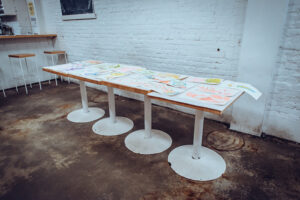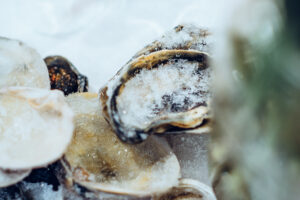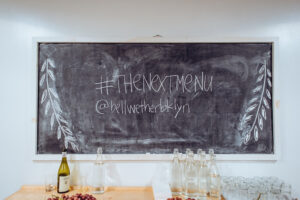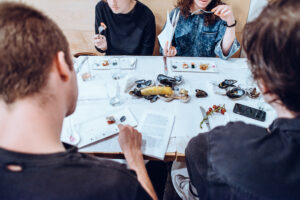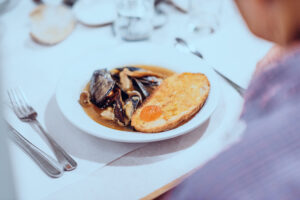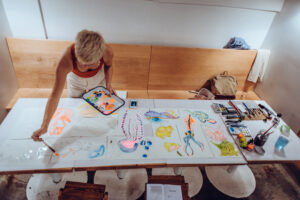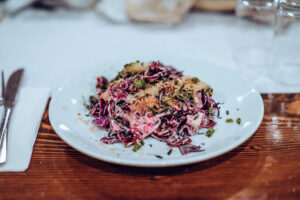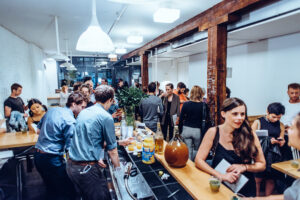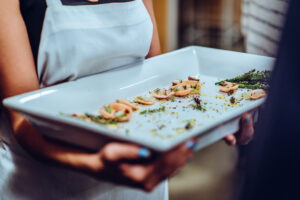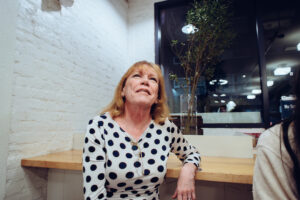
When Jordan Kisner, founder and director of the Bellwether creative collective, first approaches an artist, she asks them a simple question: What is it you want to do that you can’t?
“Throw a climate change–themed dinner party” was author Alexandra Kleeman’s answer. While this may at first seem an odd choice for a writer, Kleeman often explores subjects such as consumerism, food and societal woes—all of which relate to climate change.
To “imagine dystopia with a flavor,” as Kleeman put it, she teamed up with envelope-pushing chef Jen Monroe. Together they concocted the “next menu,” a seaside supper set 30 years down the road—at a time when scientists predict widespread water scarcity, severely impacted crop production and low-oxygen dead zones throughout the world’s oceans.
Despite the dreary overtones, last Friday, 45 curious patrons gathered at Williamsburg’s Egg to see what Kleeman and Monroe had in store. Bushels of marsh reeds took the place of water-guzzling floral bouquets, and a soundtrack of distressed coral reef field recordings conjured an oceanic dreamscape.
As guests filed in, they sipped on mezcal cocktails studded with peculiar, bright-green ice cubes. The Ninja Turtle hues, the bartender explained, actually derive from particles of spirulina, a nutritious microalga that takes up one-tenth of the space that terrestrial plants need to produce the equivalent calories and nutrients. Like a melting iceberg, the cube gradually shrunk, enhancing the cocktail’s color and infusing it with a rich, vegetal smack.
Kleeman set the otherworldly tone with recordings specially written for the event, starting with musings about long-extinct fishes kept alive only in the tales older people tell, and in fantastical drawings that younger ones make. The first course arrived: a bright, biting salad of toasted nori, sea beans, red cabbage and anchovies. Crowned with a few delectable globs of mochi, it represented a sort of chicken Caesar of the future, yet was reminiscent of dishes that can already be found on the menus of innovative Japanese kitchens.

The story of a half-starved traveler whipped into a frenzied feast by the discovery of washed-up mounds of kelp accompanied the main course—a murky medley of mussels, wakame seaweed, shrimp paste and Smallhold‘s Brooklyn-grown blue oyster mushrooms. It was like a tide pool in bowl, enhanced with a gingery kick and mopped up with bread slathered in a buttery rich sea urchin spread. Diners were invited to contribute their discarded mussel shells to the table centerpieces—a mix of crystal-coated shells, mermaid’s purses, plastic dinosaur toys, Altoid boxes and other commingling fragments of oceanic and human life.

The evening concluded with five bites crafted for five possible futures. A jellyfish buttermilk sorbet—sour, creamy and studded with pleasantly chewy bits—represented a fine-dining culture reimagined with previously “undesirable” foods. Alternatively, a blue and pink gelatin—the only objectionable item served throughout the meal—stood in for a Soylent Green–type culinary dystopia. Next, a gold leaf-topped mound of fig, honeycomb and cheese symbolized a hierarchical economy in which only the wealthy enjoy scarce foods, while a cricket flour–based apple tart sprinkled with Long Island sea salt expressed necessity-driven farm-to-table locavorism.
Finally, an empty shell represented the fifth and last possibility: failure to adapt.




